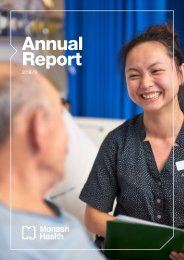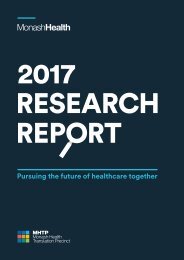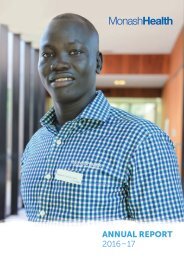Annual Report 2017-18 | Monash Health
You also want an ePaper? Increase the reach of your titles
YUMPU automatically turns print PDFs into web optimized ePapers that Google loves.
Notes to the Financial Statements<br />
<strong>Monash</strong> <strong>Health</strong> <strong>Annual</strong> <strong>Report</strong> <strong>2017</strong>/20<strong>18</strong><br />
Note 4.2 (e): Fair value determination (continued)<br />
Specialised Land and Specialised Buildings<br />
Specialised land includes Crown Land which is measured at fair value with regard to the property’s highest and best use<br />
after due consideration is made for any legal or physical restrictions imposed on the asset, public announcements or<br />
commitments made in relation to the intended use of the asset. Theoretical opportunities that may be available in relation<br />
to the assets are not taken into account until it is virtually certain that any restrictions will no longer apply. Therefore,<br />
unless otherwise disclosed, the current use of these non-financial physical assets will be their highest and best use.<br />
The market approach is used for specialised land and specialised buildings although it is adjusted for the community<br />
service obligation (CSO) to reflect the specialised nature of the assets being valued. Specialised assets contain significant,<br />
unobservable adjustments; therefore these assets are classified as Level 3 under the market based direct comparison<br />
approach.<br />
The CSO adjustment is a reflection of the valuer’s assessment of the impact of restrictions associated with an asset to the<br />
extent that is also equally applicable to market participants. This approach is in light of the highest and best use<br />
consideration required for fair value measurement, and takes into account the use of the asset that is physically possible,<br />
legally permissible and financially feasible. As adjustments of CSO are considered as significant unobservable inputs,<br />
specialised land would be classified as Level 3 assets.<br />
For <strong>Monash</strong> <strong>Health</strong>, the depreciated replacement cost method is used for the majority of specialised buildings, adjusting for<br />
the associated depreciation. As depreciation adjustments are considered as significant and unobservable inputs in nature,<br />
specialised buildings are classified as Level 3 for fair value measurements.<br />
An independent valuation of <strong>Monash</strong> <strong>Health</strong> ’s specialised land and specialised buildings was performed by the Valuer-<br />
General Victoria. The valuation was performed using the market approach adjusted for CSO. The effective date of the<br />
valuation is 30 June 2014.<br />
In June 20<strong>18</strong> a managerial valuation was carried out in accordance with FRD 103F to revalue the land to its fair value.<br />
Plant and Equipment<br />
Plant and equipment (including medical equipment, computers and communication equipment and furniture and fittings are<br />
held at carrying amount (depreciated cost). When plant and equipment is specialised in use, such that it is rarely sold other<br />
than as part of a going concern, the depreciated replacement cost is used to estimate the fair value. Unless there is market<br />
evidence that current replacement costs are significantly different from the original acquisition cost, it is considered<br />
unlikely that depreciated replacement cost will be materially different from the existing carrying amount.<br />
There were no changes in valuation techniques throughout the period to 30 June 20<strong>18</strong>.<br />
For all assets measured at fair value, the current use is considered the highest and best use.<br />
Revaluations of Non‐Current Physical Assets<br />
Non-current physical assets are measured at fair value and are revalued in accordance with FRD 103F Non-Current<br />
Physical Assets . This revaluation process normally occurs every five years, based upon the asset's Government<br />
Purpose Classification, but may occur more frequently if fair value assessments indicate material changes in<br />
values. Independent valuers are used to conduct these scheduled revaluations and any interim revaluations are<br />
determined in accordance with the requirements of the FRDs. Revaluation increments or decrements arise from<br />
differences between an asset’s carrying value and fair value.<br />
Revaluation increments are recognised in ‘Other Comprehensive Income’ and are credited directly to the asset revaluation<br />
surplus, except that, to the extent that an increment reverses a revaluation decrement in respect of that same class of<br />
asset previously recognised as an expense in net result, the increment is recognised as income in the net result.<br />
Revaluation decrements are recognised in ‘Other Comprehensive Income’ to the extent that a credit balance exists in the<br />
asset revaluation surplus in respect of the same class of property, plant and equipment.<br />
Revaluation increases and revaluation decreases relating to individual assets within an asset class are offset against one<br />
another within that class but are not offset in respect of assets in different classes.<br />
Revaluation surplus is not transferred to accumulated funds on de-recognition of the relevant asset, except where an asset<br />
is transferred via contributed capital.<br />
In accordance with FRD 103F, <strong>Monash</strong> <strong>Health</strong>'s non-current physical assets were assessed to determine whether<br />
revaluation of the non-current physical assets was required.<br />
102 <strong>Monash</strong> <strong>Health</strong> <strong>Annual</strong> <strong>Report</strong> <strong>2017</strong>-<strong>18</strong>








